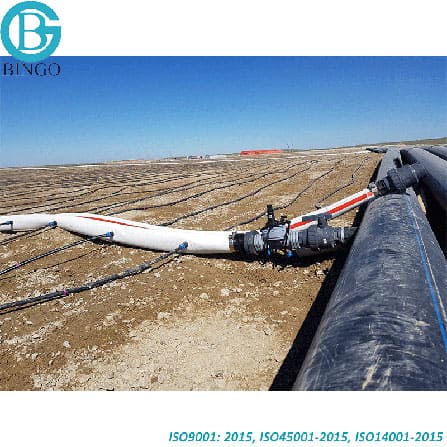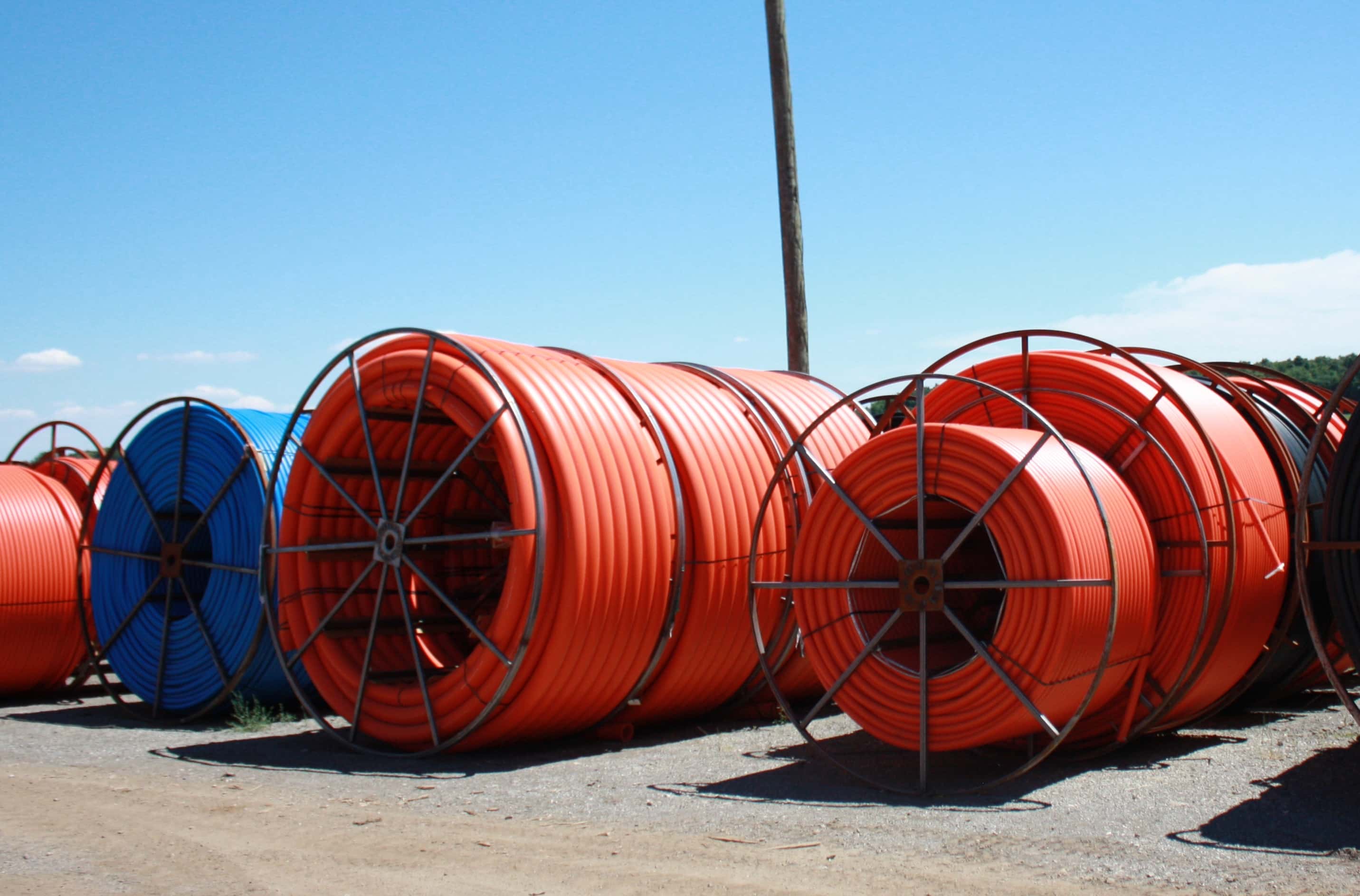How American Plastics HDPE Pipe for Oilfield Supports Energy Infrastructure
Check Out the Manufacturing Process Behind High-Quality HDPE Pipe and Its Applications
The manufacturing procedure of high-grade HDPE pipelines is detailed and methodical. It starts with the selection of raw materials that boost efficiency. Following this, ethylene undergoes polymerization to create resin, which is after that formed via extrusion. Quality assurance is critical, making certain that the final item satisfies strict standards. The journey of HDPE pipelines doesn't end with manufacturing. Their applications throughout numerous markets reveal a wider relevance worth checking out.
Comprehending HDPE: Qualities and Advantages

High-density polyethylene (HDPE) is a versatile polycarbonate understood for its resilience and resistance to different environmental elements. This product shows outstanding tensile stamina, making it appropriate for requiring applications. Its low-density structure contributes to a lightweight product, assisting in convenience of handling and setup. HDPE likewise showcases exceptional resistance to chemicals, which minimizes destruction when subjected to severe compounds.
The product's reduced moisture absorption additionally enhances its durability, making it suitable for use in pipelines and tank. Furthermore, HDPE is immune to ultraviolet (UV) radiation, making sure that items maintain their honesty even when revealed to sunlight. Moreover, its adaptability permits for the development of detailed forms without jeopardizing strength. The eco-friendly nature of HDPE, typically originated from recycled products, adds to its appeal, advertising sustainable methods in production. On the whole, these residential properties and advantages make HDPE a preferred choice for different commercial and customer applications.
Basic Material Selection for HDPE Production
The choice of resources for HDPE production is necessary to validate the last product meets the desired specifications and high quality criteria. High-density polyethylene (HDPE) is mostly created from polymerized ethylene, stemmed from nonrenewable fuel sources such as natural gas or unrefined oil. The top quality of these feedstocks greatly affects the mechanical and thermal residential properties of the last HDPE.
Additives also play a substantial function in improving HDPE's performance, consisting of anti-oxidants, UV stabilizers, and colorants, which enhance sturdiness and resistance to environmental elements. The selection procedure should consider not just the chemical composition of the raw products however also their handling features to guarantee reliable production.
The sourcing of raw products ought to prioritize sustainability and compliance with ecological policies, as liable techniques are crucial in today's market. Ultimately, careful raw product choice lays the foundation for creating high-quality HDPE pipelines suitable for diverse applications.
The Extrusion Refine: Forming HDPE Pipeline
The extrusion procedure plays a crucial duty in shaping HDPE pipelines, starting with meticulous product prep work techniques that ensure suitable circulation and consistency. Similarly vital is the design of the die, which directly affects the last measurements and surface top quality of the pipe. With each other, these factors contribute greatly to the efficiency and quality of HDPE pipe production.
Material Preparation Techniques
Effective production of HDPE pipelines starts with meticulous material preparation techniques, especially the extrusion procedure. Throughout this phase, high-density polyethylene material is initial dried out to get rid of wetness, making certain optimal flow characteristics. The material is then fed into the extruder, where it goes through home heating and melting, changing into a viscous state. This home heating procedure is very carefully regulated to keep the product's honesty and performance. The molten HDPE is forced via a die, forming it right into a constant pipe form. Proper temperature level monitoring throughout extrusion is essential, as it straight impacts the material's residential properties and the final product top quality. As soon as shaped, the HDPE pipe is cooled down and cut to specified sizes, prepared for succeeding handling and applications.
Die Style Value
Accuracy in die design plays an important duty in the extrusion process of HDPE pipes. The die works as the final shaping device, directly affecting the pipe's dimensions, wall density, and surface area finish. A well-designed die warranties uniform product flow, decreasing defects such as irregularities and weak points. The geometry of the die need to be optimized to suit the particular properties of HDPE, including its viscosity and thermal actions during extrusion. In addition, the cooling price of the material as it travels through the die can considerably affect plumber gas line repair the pipeline's architectural honesty. Subsequently, buying advanced die technology is vital for suppliers aiming to generate premium HDPE pipelines that meet sector criteria and customer expectations.
Quality Assurance Actions in HDPE Production
Various elements influence the top quality of HDPE pipe production, reliable top quality control measures are essential to assure uniformity and dependability in the final product (Pipe Manufacturing Midland TX). Key top quality control methods include extensive product examination, validating that the raw polyethylene fulfills well-known criteria for purity and thickness. During the extrusion process, criteria such as temperature level, pressure, and cooling time are very closely monitored to keep dimensional accuracy and architectural integrity
Additionally, post-production screening is vital; makers typically conduct hydrostatic examinations to evaluate the pipeline's stamina and resistance to stress. Visual inspections for surface area defects better improve top quality guarantee. Accreditation from pertinent requirements companies, like ASTM or ISO, provides an added layer of reputation. By executing these thorough quality control steps, suppliers can reduce issues, improve performance, and ensure that the HDPE pipes fulfill the specific requirements of different applications, inevitably leading to client satisfaction and count on the item.
Applications of HDPE Pipe Throughout Industries
HDPE pipelines are used across numerous fields as a result of their longevity and convenience. In water circulation systems, they assure effective distribution, while in wastewater administration, they offer trusted services for waste transport. Furthermore, farming watering networks gain from HDPE's resistance to deterioration and flexibility, making it an excellent option for modern farming methods.

Water Circulation Systems
A substantial number of sectors rely upon high-density polyethylene (HDPE) pipes for reliable water circulation systems. Understood for their sturdiness and resistance to rust, HDPE pipes are extensively utilized in local water networks, agricultural watering, and industrial applications. Their light-weight nature helps with very easy handling and installment, minimizing labor prices and time. Additionally, HDPE pipelines can fit various stress levels, making them suitable for both reduced and high-pressure systems. American Plastics HDPE Pipe for Oilfield. The versatility of the product enables smooth combination into existing framework, minimizing the need for substantial excavation. Additionally, HDPE's resistance to chemical seeping assurances that the water provided stays secure and tidy, making it an ideal choice for preserving the high quality of drinkable water across numerous sectors
Wastewater Monitoring Solutions
Reliable water distribution systems likewise lead the means for ingenious wastewater monitoring options, where high-density polyethylene (HDPE) pipes play a substantial function. Renowned for their resilience and resistance to deterioration, HDPE pipelines are optimal for transferring wastewater in different setups. Their adaptability permits very easy setup in complex settings, reducing the requirement for extensive excavation. Furthermore, HDPE's smooth interior surface area minimizes rubbing, enhancing flow rates and effectiveness. These pipelines are likewise immune to chemical leaching, making certain that contaminants do not jeopardize the surrounding atmosphere. Industries, districts, and treatment facilities increasingly depend on HDPE pipes for their reliability and longevity, making them a recommended selection for modern-day wastewater administration systems. This versatility underscores the crucial significance of HDPE pipes throughout many applications.
Agricultural Irrigation Networks
Agricultural irrigation networks profit substantially from making use of high-density polyethylene (HDPE) pipes, which give efficient and reputable water distribution to crops. HDPE pipelines are lightweight, making them simple to transfer and mount, while their versatility enables numerous setups in diverse surfaces. These pipes show outstanding resistance to corrosion, chemicals, and UV radiation, making sure toughness in severe farming atmospheres. Additionally, their smooth indoor surface decreases rubbing loss, enhancing water flow and reducing power prices linked with pumping. The long life of HDPE pipes, commonly going beyond half a century, contributes to reduce maintenance and replacement costs. Subsequently, farmers increasingly count on HDPE pipes to enhance watering performance and advertise sustainable agricultural practices, eventually bring about boosted crop yields and source preservation.
Future Trends in HDPE Pipeline Modern Technology
As the need for sustainable and efficient framework grows, developments in HDPE pipeline innovation are poised to transform numerous markets. Arising trends include the combination of clever technologies, such as sensors and IoT capacities, which facilitate real-time tracking of pipe problems, lowering upkeep costs and stopping leakages. In addition, the growth of advanced manufacturing techniques, such as 3D printing, is enabling the production of facility, customized pipe styles that cater to certain task demands.
In addition, the emphasis on recycling and round economy practices is driving the innovation of HDPE pipes made from recycled materials, enhancing sustainability. Improved jointing techniques, such as electro-fusion and mechanical fittings, are likewise improving installation efficiency and reliability. The expanding emphasis on environmental laws is pressing suppliers to take on greener production processes, making certain that HDPE pipelines not only fulfill industry criteria however also cultivate a more lasting future for facilities development.
Regularly Asked Inquiries
Exactly How Does HDPE Compare to Various Other Plastic Products?
HDPE exceeds numerous other plastic materials relating to durability, chemical resistance, and adaptability. Its low density and high tensile strength make it suitable for different applications, typically going beyond alternatives in both efficiency and durability.
What Are the Environmental Effects of HDPE Production?
The environmental influences of HDPE production include greenhouse gas discharges, energy intake, and prospective pollution from making procedures. Additionally, improper disposal can lead to soil and water contamination, increasing worries regarding long-lasting eco-friendly effects.
Can HDPE Piping Be Recycled?
Yes, HDPE pipes can be reused. Lots of centers approve used HDPE for processing, changing it right into brand-new products. This recycling adds to sustainability initiatives, decreasing plastic waste while preserving resources and energy in the production cycle.
What Is the Lifespan of HDPE Water Lines?

Just How Do Temperature Level Variations Affect HDPE Pipe Performance?
Temperature variations considerably influence HDPE pipeline efficiency, impacting adaptability and toughness. High temperatures can result in softening, while reduced temperature levels might create brittleness, inevitably affecting the pipeline's longevity and viability for various applications in diverse environments.